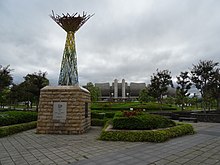CSE 미션
CSES MissionCSES([2]China Seasemo-Electromagnetic Satellite)[1] 또는 Zhangengy는 가까운 지구 공간에서 자연원과 인공 방출체에 의해 유도되는 전자기장과 파동, 플라즈마 파라미터 및 입자 유동 모니터링을 전담하는 중국-이탈리아 우주 임무다. 오스트리아는 자기계 중 하나에 기여한다.
첫 CSES 위성은 2018년 2월 2일 고비사막(내몽골) 주취안 위성발사센터에서 발사되었다. 예상 임무 수명은 5년이다.
개요
이 임무는 이온-자기권 섭동의 관찰과 내부 밴 앨런 벨트의 입자 침전 및 지진 사건 발생 사이의 가능한 (임시 및 공간적) 상관관계의 존재에 대한 연구를 목적으로 한다.[3][4][5] 그러나 지진과 관련될 수 있는 측정치와 태양 활동과 대류권 전자기 방출에 의해 지구자기강에서 생성되는 큰 배경을 구별하기 위해서는 세심한 분석이 필요하다.[6][7]
CSE 임무는 상층 전리층의 구조와 역동성, 상층 대기권, 전리권과 자기권 사이의 연결 메커니즘과 지구자기장의 시간적 변화를 조용하고 교란된 조건에서 조사한다. 이 임무에 의해 수집된 데이터는 태양-지구적 상호작용과 태양 물리학의 현상, 즉 코로나 질량 방출(CME), 태양 플레어 및 우주선 태양 변조를 연구할 수 있게 될 것이다. 이 임무는 국제 협력과 과학 공동체를 위한 관찰 공유 서비스 개발에 기여할 것이다.
이 임무는 중국 국가우주국(CNSA)과 이탈리아 우주국(ASI)의 협력 프로그램의 일환이다. 쉬후이셴 교수가 이끄는 중국 지진청(CEA)의 중국 연구진과 로베르토 바티스톤 교수가 이끄는 국립원자력물리연구소(INFN)와 다른 연구소·대학의 이탈리아 연구진이 공동 연구한 결과다.[citation needed]
기관
The Chinese institutes involved in the project are the China National Space Administration (CNSA), the China Earthquake Administration (CEA), the Lanzhou Institute of Physics (LIP), the Institute of Crustal Dynamics (ICD-CEA), the Institute of High Energy Physics (IHEP), the National Space Science Center (NSSC), the Centre for Space Science and App리서치-중국과학아카데미(CSSAR-CAS), 스페이스 스타 테크놀로지, DFH 인공위성 등이 거짓말을 했다.[8]
이탈리아는 리마두(Limadou) 교수 주도로 CSE 임무에 참여한다. 이탈리아 우주국(ASI)과 국립핵물리연구소(INFN)의 자금 지원을 받는 피에르조르지오 피코자(Piergiorgio Picoza, Principal Investigator, Principal Investigator)가 후원한다. The Limadou Collaboration includes the INFN Divisions of Bologna, Naples, Perugia, Roma Tor Vergata, the INFN Center TIFPA of Trento, the INFN National Laboratories of Frascati, the Universities of Bologna, Trento, Roma Tor Vergata, Uninettuno and the Institutes INAF-IAPS (Italian National Institute of Astrophysics and Planetology) and INGV (Itali국립 지구물리학 및 화산학 연구소
LIMADOU 협업은 (내진 및 비내진 전자기 동요의 결과) 내부 밴 앨런 벨트로부터 침전하는 에너지 충전 입자 검출의 최적화를 위해 고안된 CSE 임무의 고에너지 입자 검출기(Heigh Energy Partic Detector, HEPD)를 설계, 구축 및 테스트했으며, 이를 개발 및 테스트하는 데 협력했다.로마 INAF-IAPS 플라즈마 챔버의 eEFD(Electronic Field Detector, EFD)이며, CSES 임무의 모든 탑재량에 대한 데이터 분석에 참여한다.
위성 및 계기
CSES는 중국 CAST2000 플랫폼을 기반으로 한 3축 안정화 위성으로, 약 730kg의 질량과 약 900W의 전력 소비 피크다. 과학 데이터는 120 Mbit/s로 X-band로 전송될 것이다. 궤도는 약 500km 고도에서 약 98°의 기울기, 14:00 LT에서 하강 노드인 원형의 태양 동기식이다.[1]
The CSES payload includes: two particle detectors (the High-Energy Particle Detectors (HEPD) and the High-Energy Particle Package (HEPP)) to measure flux, energy spectrum, type and direction of impinging particles; a Search-Coil Magnetometer (SCM) and a High Precision Magnetometer (HPM) to measure the components and the total intensity of the magne각각 tic 필드, 넓은 주파수 범위에서 전기장 구성요소를 측정하기 위한 4개의 프로브 전기장 검출기(EFD), 플라스마 파라미터를 측정하기 위한 Plasma Analyzer Package(PAP) 및 LP(Langmuir Probe); 전자 밀도를 측정하고 이온권 단층촬영을 수행하기 위한 GNSS Occultation Receiver 및 Tri-Band Bevaclevaconeacher. [9]
The High Precision Magnetometer (HPM) is developed in cooperation between the National Space Science Center (NSSC) of the Chinese Academy of Sciences, the Space Research Institute (IWF) of the Austrian Academy of Sciences (ÖAW) and the Institute of Experimental Physics (IEP) of the Graz University of Technology. NSSC는 듀얼 센서 플럭스게이트 자기계, 계기판 프로세서, 전원 공급 장치를 담당하고 IWF와 IEP는 스칼라 자기계(CDSM)로 참가한다.[10]
각 계측기는 위성이 중국과 지구의 더 많은 지진 지역을 통과할 때 활성화되는 '버스트 모드'와 플래닛의 다른 지역에 대한 '조사 모드'의 두 가지 작동 모드로 데이터를 수집한다.[1]
-65°~+65° 사이의 지자기 위도에 대한 (계기가 데이터를 수집하는 곳) '유하중 작동 구역'과 (위성 자세 제어와 궤도 유지 활동을 수행하기 위해 모든 검출기를 꺼두는 곳) '플랫폼 조정 구역'의 두 가지 다른 궤도 작업 구역이 있다..[1]
참조
- ^ a b c d CSES 웹 사이트 http://cses.roma2.infn.it/
- ^ "CSES / Zhangheng 1". eoPortal. ESA. 2020. Retrieved 9 December 2021.
- ^ Aleksandrin, S. Yu; Galper, A. M; Grishantzeva, L. A; Koldashov, S. V; Maslennikov, L. V; Murashov, A. M; Picozza, P; Sgrigna, V; Voronov, S. A (2003). "High-energy charged particle bursts in the near-Earth space as earthquake precursors". Annales Geophysicae. 21 (2): 597–602. Bibcode:2003AnGeo..21..597A. doi:10.5194/angeo-21-597-2003.
- ^ Sgrigna, V; Carota, L; Conti, L; Corsi, M; Galper, A.M; Koldashov, S.V; Murashov, A.M; Picozza, P; Scrimaglio, R; Stagni, L (2005). "Correlations between earthquakes and anomalous particle bursts from SAMPEX/PET satellite observations". Journal of Atmospheric and Solar-Terrestrial Physics. 67 (15): 1448–62. Bibcode:2005JASTP..67.1448S. doi:10.1016/j.jastp.2005.07.008.
- ^ De Santis, A; De Franceschi, G; Spogli, L; Perrone, L; Alfonsi, L; Qamili, E; Cianchini, G; Di Giovambattista, R; Salvi, S; Filippi, E; Pavón-Carrasco, F.J; Monna, S; Piscini, A; Battiston, R; Vitale, V; Picozza, P.G; Conti, L; Parrot, M; Pinçon, J.-L; Balasis, G; Tavani, M; Argan, A; Piano, G; Rainone, M.L; Liu, W; Tao, D (2015). "Geospace perturbations induced by the Earth: The state of the art and future trends" (PDF). Physics and Chemistry of the Earth, Parts A/B/C. 85–86: 17–33. Bibcode:2015PCE....85...17D. doi:10.1016/j.pce.2015.05.004.
- ^ Battiston, Roberto; Vitale, Vincenzo (2013). "First evidence for correlations between electron fluxes measured by NOAA-POES satellites and large seismic events". Nuclear Physics B - Proceedings Supplements. 243–244: 249–57. Bibcode:2013NuPhS.243..249B. doi:10.1016/j.nuclphysbps.2013.09.002.
- ^ Tao, Dan; Battiston, Roberto; Vitale, Vincenzo; Burger, William J; Lazzizzera, Ignazio; Cao, Jinbin; Shen, Xuhui (2016). "A new method to study the time correlation between Van Allen Belt electrons and earthquakes". International Journal of Remote Sensing. 37 (22): 5304–19. Bibcode:2016IJRS...37.5304T. doi:10.1080/01431161.2016.1239284. hdl:11572/153994. S2CID 125364716.
- ^ DFH 위성 주식회사(DFHSAT) http://www.cast.cn/Item/list.asp?id=1814
- ^ Kunitsyn, Viacheslav E.; Tereshchenko, Evgeni D. (2003). Ionospheric Tomography. Physics of Earth and Space Environments. Springer. p. 276. ISBN 9783540004042.
- ^ http://www.iwf.oeaw.ac.at/en/missions/future-missions/cses/



